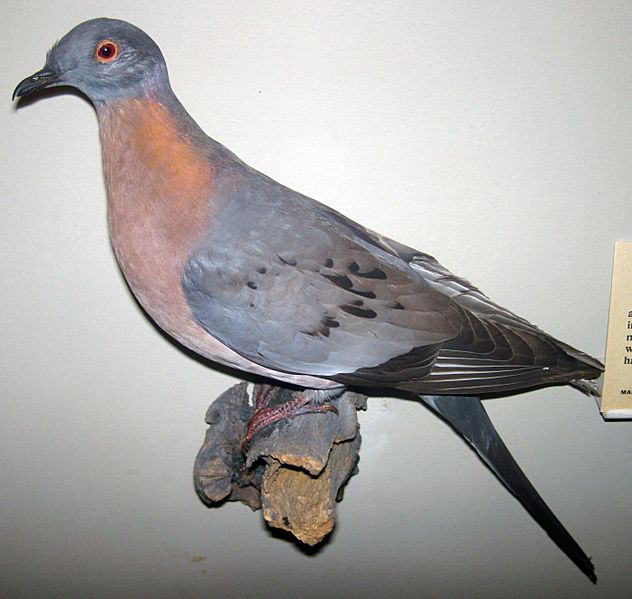Image: Ectopistes migratorius (passenger pigeon)

Description: Ectopistes migratorius (Linnaeus, 1766) - passenger pigeon (extinct) (mount, public display, Field Museum of Natural History, Chicago, Ilinois, USA). The story of the passenger pigeon is famous as an example of the idiotic destructive power of modern man ("Homo stupidus") & human overpopulation. The passenger pigeon, Ectopistes migratorius, was at one time the # 1 most abundant bird in North America, and likely the # 1 most abundant bird on Earth. The species became extinct about 100 years ago. The last known individual was a captive bird held at the Cincinnati Zoo. It died at 1 PM on 1 September 1914. It is the only species whose extinction timing is very well known. Ectopistes migratorius occupied the central & eastern portions of temperate North America. It was driven to extinction by professional hunters (the birds were destined for food markets - American Indians also killed these birds as a source of food) and clear-cutting of forests. Passenger pigeon flocks were famously huge - they darkened skies and took hours to fly by. Their droppings fell like snow. Individual flocks were estimated to have contained more than three billion birds. Flock density was so high that when two flocks flying in opposite directions collided, numerous stunned birds fell to the ground. Passenger pigeons nested in huge colonies, occupying hundreds of square miles of forests. Single trees could have hundreds of nests. Tree branches were seen to break from the weight of all the perching birds. Late 1800s hunters targeted the nesting colony areas. Oddly, passenger pigeons couldn’t nest alone or in small colonies. With the destruction of the nesting colonies, the species couldn’t make a comeback. The passenger pigeon is the only species in the pigeon/dove family driven to extinction by gun nerds. However, several other birds in this family, usually island species, have gone also extinct due to other human factors. The Lesson? Natural resources can run out. (think oil as well) Classification: Animalia, Chordata, Vertebrata, Aves, Columbiformes, Columbidae Birds are small to large, warm-blooded, egg-laying, feathered, bipedal vertebrates capable of powered flight (although some are secondarily flightless). Many scientists characterize birds as dinosaurs, but this is consequence of the physical structure of evolutionary diagrams. Birds aren’t dinosaurs. They’re birds. The logic & rationale that some use to justify statements such as “birds are dinosaurs” is the same logic & rationale that results in saying “vertebrates are echinoderms”. Well, no one says the latter. No one should say the former, either. However, birds are evolutionarily derived from theropod dinosaurs. Birds first appeared in the Triassic or Jurassic, depending on which avian paleontologist you ask. They inhabit a wide variety of terrestrial and surface marine environments, and exhibit considerable variation in behaviors and diets.
Title: Ectopistes migratorius (passenger pigeon)
Credit: Ectopistes migratorius (passenger pigeon) 5
Author: James St. John
Usage Terms: Creative Commons Attribution 2.0
License: CC BY 2.0
License Link: http://creativecommons.org/licenses/by/2.0
Attribution Required?: Yes
Image usage

